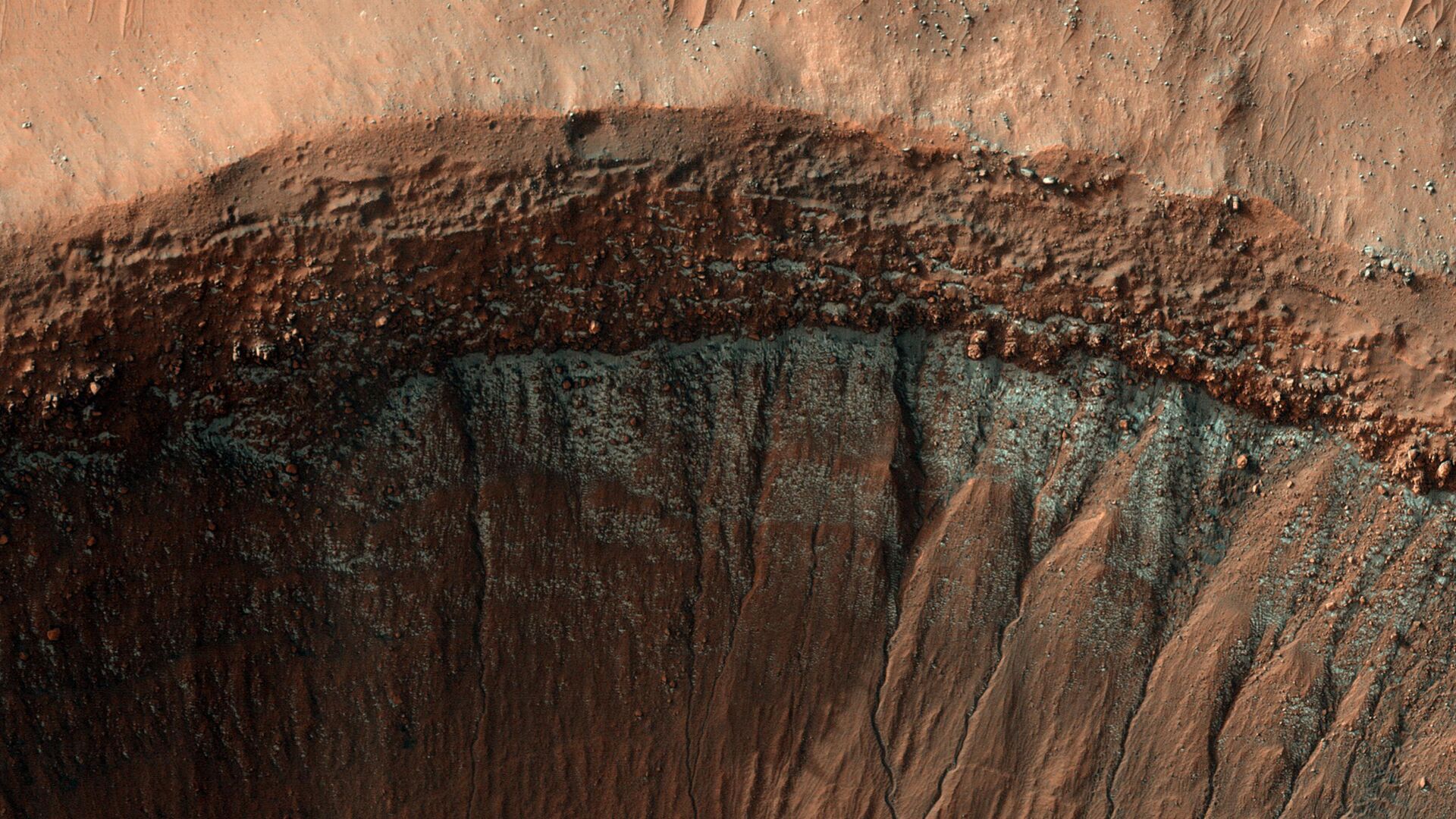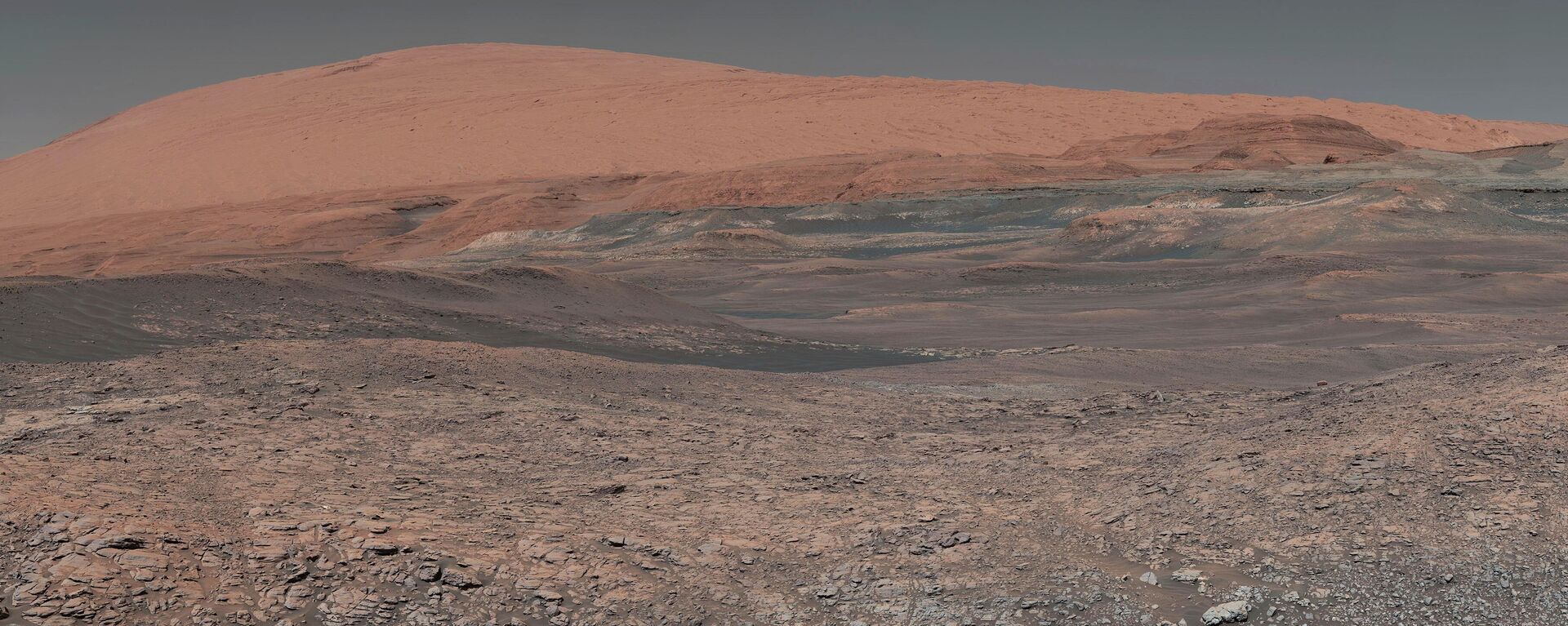https://sputnikglobe.com/20220629/radiation-on-mars-likely-destroyed-all-evidence-of-life-on-the-surface-now-nasa-needs-to-dig-1096772576.html
Radiation on Mars Likely Destroyed All Evidence of Life on the Surface. Now, NASA Needs to Dig
Radiation on Mars Likely Destroyed All Evidence of Life on the Surface. Now, NASA Needs to Dig
Sputnik International
NASA has sent five rovers to Mars: Sojourner, 1997; Spirit and Opportunity, 2004; Curiosity, 2012; and Perseverance, 2021. Unfortunately, none of them can dig... 29.06.2022, Sputnik International
2022-06-29T00:47+0000
2022-06-29T00:47+0000
2022-11-30T10:10+0000
nasa
technology
science & tech
mars
https://cdn1.img.sputnikglobe.com/img/07e6/04/0f/1094792715_0:90:2880:1710_1920x0_80_0_0_ad15370c44bf1fb119c3e55c3f7acb6d.jpg
If we want to find evidence of life on Mars, we are going to have to dig deep, six feet deep to be exact, according to NASA.Thanks to an experiment performed by NASA at the Goddard Space Flight Center in Greenbelt Maryland, scientists now believe that any amino acids near the surface of Mars would break down much faster than previously thought.Amino acids are fundamental to life. Organic terrestrial life uses amino acids to create proteins that are then used to make enzymes that regulate chemical reactions and structures. Amino acids can exist without life, so finding them on Mars would not prove life existed on the planet, but it would be a strong piece of evidence.However, amino acids on Mars would be subjected to cosmic radiation from the Sun, destroying them and any trace that they ever existed. Earth’s magnetic field and thick atmosphere protect amino acids, and all of life, from the cosmic radiation output by the Sun. But Mars does not currently have a magnetic field and its atmosphere is thin and unstable compared to ours.However, scientists do not believe that was always the case. Most scientists believe that Mars once had a thick atmosphere and a magnetic field. That, along with evidence that the planet once had water on its surface, leads them to believe the Red Planet may have been habitable long ago.The Mars rovers currently searching for life on the planet are only capable of digging a few inches below the surface. NASA scientists now believe it would only take 20 million years, a short time geologically speaking, for the Sun’s harmful rays to penetrate the surface and erase any evidence that amino acids existed there.In fact, they estimate that any amino acids near the surface earlier than 100 million years ago have likely been completely destroyed by the Sun’s cosmic rays. 100 million years may seem like a long time, but scientists believe it has been billions of years since Mars resembled a habitable planet.If scientists can dig significantly deeper, they may be able to find some amino acids. Two meters, or a little more than six feet, is how far they believe we will have to dig to find amino acids on Mars if they exist at all.Previously, scientists thought evidence of amino acids would survive much longer, but this new experiment took amino acids and mixed them in a test tube with soil meant to mimic Martian soil. They then blasted it with radiation equivalent to that of 80 million years of exposure on Mars. Previous experiments only blasted the amino acids, without the soil simulation, and that may have resulted in an inaccurate estimate of their viability.Amino acids have been found off-planet before. Scientists observed them in the asteroid Rygu and in the atmosphere of Comet 67P. Amino acids were also found in a meteorite believed to come from Mars, and scientists believe, though they aren’t certain, that those amino acids came from Mars and not from contamination on Earth.If NASA hopes to find amino acids on Mars, they need to send something that can dig deeper than their current rovers.
https://sputnikglobe.com/20220617/scientists-question-existing-theories-on-mars-origins-amid-new-finding-in-200-year-old-meteorite--1096419375.html
https://sputnikglobe.com/20220527/why-did-mars-dry-out-new-study-gives-a-clue-1095819008.html
mars
Sputnik International
feedback@sputniknews.com
+74956456601
MIA „Rossiya Segodnya“
2022
News
en_EN
Sputnik International
feedback@sputniknews.com
+74956456601
MIA „Rossiya Segodnya“
Sputnik International
feedback@sputniknews.com
+74956456601
MIA „Rossiya Segodnya“
nasa, technology, science & tech, mars
nasa, technology, science & tech, mars
Radiation on Mars Likely Destroyed All Evidence of Life on the Surface. Now, NASA Needs to Dig
00:47 GMT 29.06.2022 (Updated: 10:10 GMT 30.11.2022) NASA has sent five rovers to Mars: Sojourner, 1997; Spirit and Opportunity, 2004; Curiosity, 2012; and Perseverance, 2021. Unfortunately, none of them can dig more than a few inches under the surface of the Red Planet.
If we want to find evidence of life on Mars, we are going to have to dig deep, six feet deep to be exact, according to NASA.
Thanks to an experiment performed by NASA at the Goddard Space Flight Center in Greenbelt Maryland,
scientists now believe that any amino acids near the surface of Mars would break down much faster than previously thought.
Amino acids are fundamental to life. Organic terrestrial life uses amino acids to create proteins that are then used to make enzymes that regulate chemical reactions and structures. Amino acids can exist without life, so finding them on Mars would not prove life existed on the planet, but it would be a strong piece of evidence.
However, amino acids on Mars would be subjected to cosmic radiation from the Sun, destroying them and any trace that they ever existed. Earth’s magnetic field and thick atmosphere protect amino acids, and all of life, from the cosmic radiation output by the Sun. But Mars does not currently have a magnetic field and its atmosphere is thin and unstable compared to ours.
However, scientists do not believe that was always the case. Most scientists believe that Mars once had a thick atmosphere and a magnetic field. That, along with evidence that the planet once had water on its surface, leads them to believe the Red Planet may have been habitable long ago.
The Mars rovers currently searching for life on the planet are only capable of digging a few inches below the surface. NASA scientists now believe it would only take 20 million years, a short time geologically speaking, for the Sun’s harmful rays to penetrate the surface and erase any evidence that amino acids existed there.
In fact, they estimate that any amino acids near the surface earlier than 100 million years ago have likely been completely destroyed by the Sun’s cosmic rays. 100 million years may seem like a long time, but scientists believe it has been billions of years since Mars resembled a habitable planet.
If scientists can dig significantly deeper, they may be able to find some amino acids. Two meters, or a little more than six feet, is how far they believe we will have to dig to find amino acids on Mars if they exist at all.
Previously, scientists thought evidence of amino acids would survive much longer, but this new experiment took amino acids and mixed them in a test tube with soil meant to mimic Martian soil. They then blasted it with radiation equivalent to that of 80 million years of exposure on Mars. Previous experiments only blasted the amino acids, without the soil simulation, and that may have resulted in an inaccurate estimate of their viability.
“It turns out that the addition of silicates and particularly silicates with perchlorates greatly increases the destruction rates of amino acids,” said the paper’s lead author and physicist Alexander Pavlov.
Amino acids have been found off-planet before. Scientists observed them in the asteroid Rygu and in the atmosphere of Comet 67P. Amino acids were also found in a meteorite believed to come from Mars, and scientists believe, though they aren’t certain, that those amino acids came from Mars and not from contamination on Earth.
If NASA hopes to find amino acids on Mars, they need to send something that can dig deeper than their current rovers.



